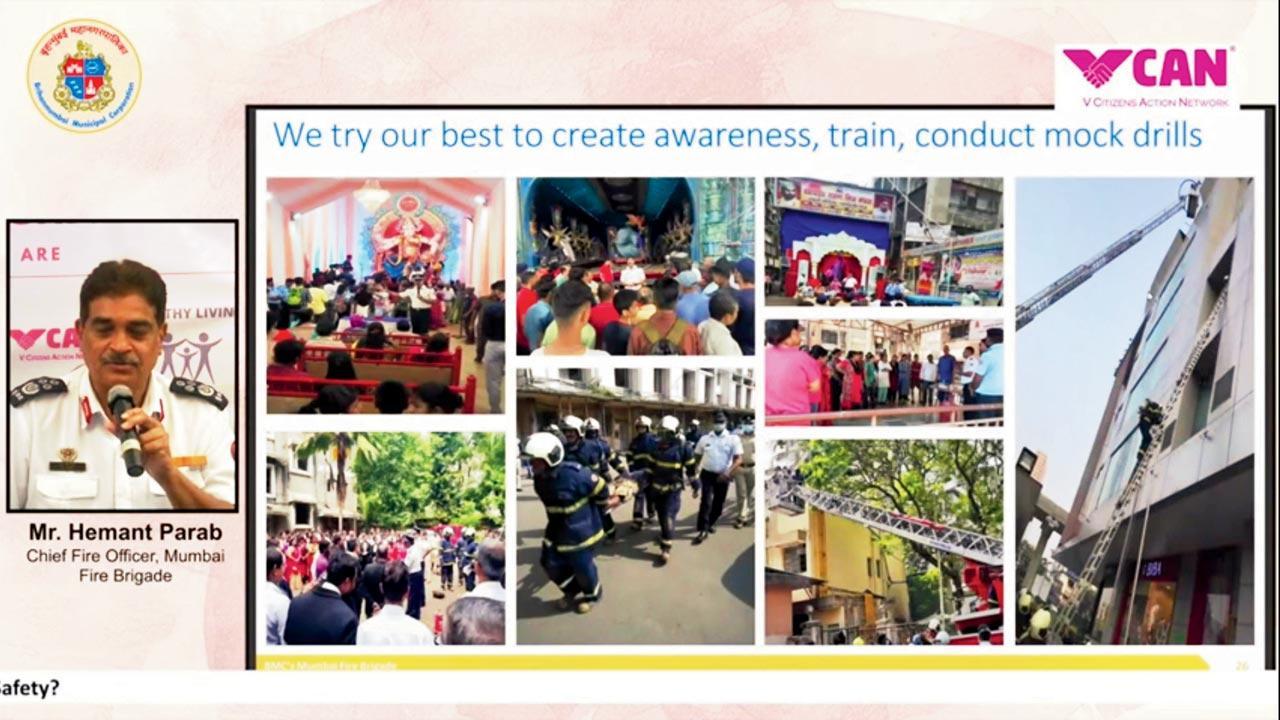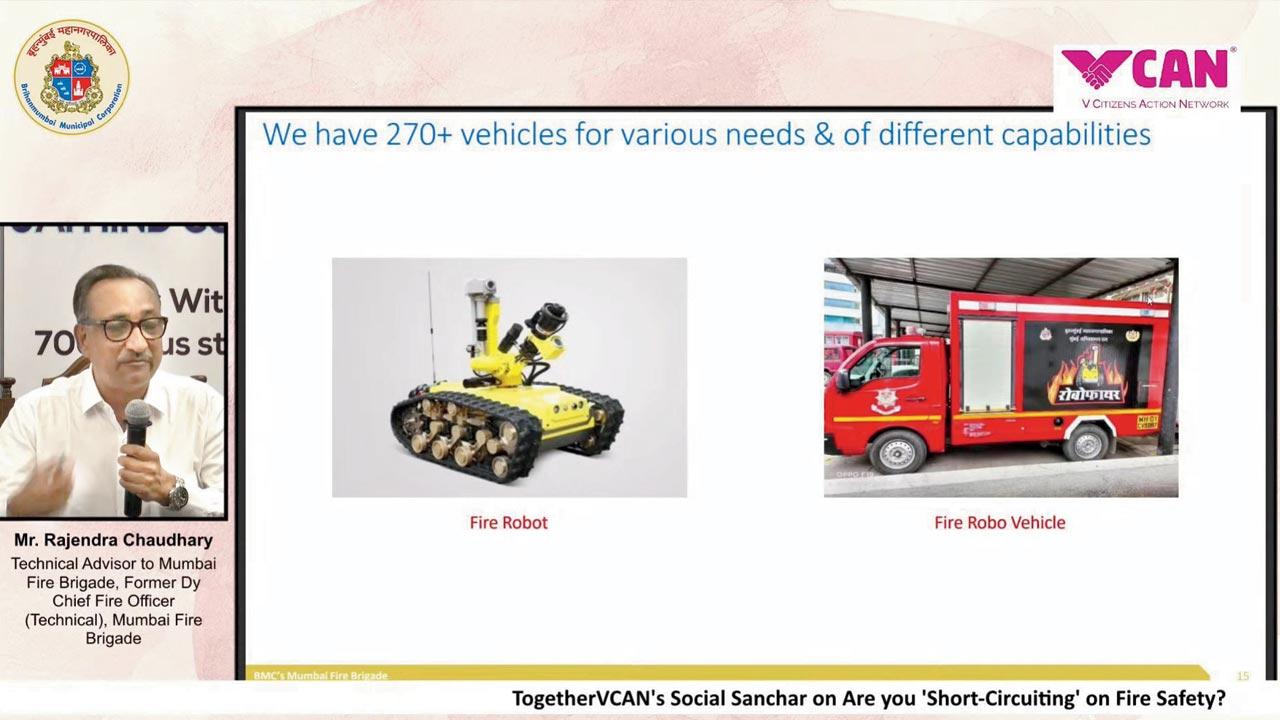As Mumbai buildings shoot up into the sky, the expert added, “Our tallest ladder is up to 90 metres, which is 30 floors. We are trying to bring in drone technology for firefighting"

Hemant Parab shares his message aided by slides
In what was termed as a burning issue, pun firmly intended, fire experts and civic officials came together to focus on fire safety. They addressed both an online and physically present audience.
ADVERTISEMENT
This social sanchar (meet) was headlined ‘Are you short-circuiting on fire safety?’ and was held at the Royal Bombay Yacht Club, Colaba on Tuesday evening. It was organised by V-CAN (V-Citizens Action Network), a non-profit designed to create linkages between government officials and people.
 Rajendra Chaudhary outlines the role of technology in firefighting
Rajendra Chaudhary outlines the role of technology in firefighting
Indrani Malkani, V-CAN chief, explained in her introduction at the outset, “Unfortunately, Mumbai is no stranger to fire. One of the major reasons for fires is short circuits. When we are not compliant or conscious of safety measures, we have disasters like fires.”
Also Read: Mumbai: Colaba residents turn up noses at ‘smelly’ Sassoon Dock
Unsafe renovations
First up, Rudreshwar Malkani shared from Ajit Kumar Jain’s paper. Jain, former additional chief secretary, Maharashtra, who was supposed to moderate the discussion, was absent. Yet, he did share his views, which were read out by Malkani. It said, “Over the past 20 years, we have seen monumental growth in construction in the city. We now have buildings competing with the Eiffel Tower in height. Firefighting becomes a huge challenge. Then, we have old buildings, which pose yet another challenge as they do not have open areas, fire refuges or firefighting systems.”
Jain also cautioned, “Internal renovations and alterations in homes are done in the name of interior design. Yet, some of these can pose fire hazards if there is improper wiring and false ceilings. Fire safety inspections in all buildings are mandated by the rule book twice a year through licensed agencies. The compliance report has to be sent to the fire department. This is not being done. If it is done at all, passive features like wiring or fire escape routes are not considered at the time of inspection.”
Tech talk
Hemant Parab, the man in the hot seat—literally, since he is chief fire officer, BMC, Mumbai Fire Brigade—said in his presentation, “Mumbai has 27,000 persons per square kilometre and we have four million structures under different planning authorities. We have 35 fire stations in Mumbai—15 in the city, 13 in the western suburbs and seven in the eastern suburbs. We have introduced 19 mini fire stations too.”
Then, Rajendra Chaudhary, technical advisor to the Mumbai Fire Brigade, explained, “Housing societies are very dynamic and changing constantly, and our firefighting technology has to keep pace. Unless you have a good, very modern fleet of machines, you cannot deliver during emergencies.”
Chaudhary, through slides, showed different fire trucks used for various classes of fires. “We do not have enough water in our fire hydrants here, so the fire brigade has to carry its own water,” he explained showing a jumbo fire truck.
As Mumbai buildings shoot up into the sky, the expert added, “Our tallest ladder is up to 90 metres, which is 30 floors. We are trying to bring in drone technology for firefighting.”
Chaudhary said, “We even have a fire robot. Where sending in personnel is life-threatening, there are robots to do that job. These can be used effectively when there is a fire in the basement, or in chemical industries. The Mumbai Fire Brigade’s technical capability is at par with any developed country.”
Wrap up
All panellists, while outlining firefighting challenges and efforts, stressed the citizen factor. Parab added, “We have fire volunteer training, where we are training the public. We have trained hospitality industry staffers and we also have an LPG awareness programme. We train housewives on reaction to gas leakage. At least 70 per cent of fire calls are due to electrical origins.”
Since the electrical origin, which meant short-circuits, was pointed out, Dinesh Khonde, chief electrical inspector, Maharashtra, said, “We have recently issued an advisory for elevators, and a safety advisory for electrical charging vehicles too, which will be on the website for the public.”
Arvind Mandke, former chief fire officer, Thane Municipal Corporation, red-flagged non-functional and poorly maintained in-built firefighting systems, saying they are very challenging for firefighters who enter a building to battle a blaze.
The two-hour presentation wrapped up with Parab’s words of wisdom: “We can’t do it all on our own. Please gather reliable information. Participate in our drives, spread knowledge and be vigilant. Fire safety is everybody’s responsibility.”
 Subscribe today by clicking the link and stay updated with the latest news!" Click here!
Subscribe today by clicking the link and stay updated with the latest news!" Click here!







